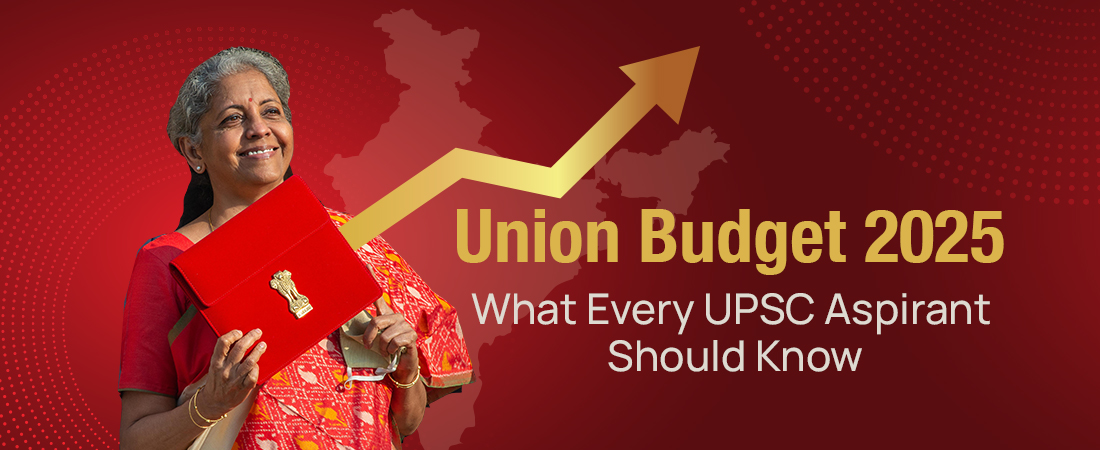
The Union Budget is a critical component of India’s economic framework, and understanding its nuances is essential for UPSC aspirants. This article delves into the Union Budget 2025 key highlights including important terms, concepts, and current affairs related to the Budget, providing a comprehensive guide to help you master this topic for the UPSC Prelims and Mains.
1. Revenue Receipts
- Definition: Government earnings from taxes, fines, and fees that do not impact assets or liabilities.
- Examples: Income tax, corporate tax, customs duties.
- 2025 Focus: Enhancing direct tax compliance and improving GST collection efficiency.
2. Capital Receipts
- Definition: Funds raised through borrowings, asset sales, or investments, affecting government liabilities.
- Examples: Disinvestment of PSUs, government bonds, loans from the World Bank.
- 2025 Focus: Increased reliance on disinvestment and foreign borrowing to manage fiscal targets.
3. Revenue Expenditure
- Definition: Routine government spending on administration and welfare, not leading to asset creation.
- Examples: Salaries, subsidies, interest payments.
- 2025 Focus: Rationalizing subsidies and controlling non-essential spending to reduce fiscal stress.
4. Capital Expenditure (CapEx)
- Definition: Investment in infrastructure and long-term asset creation.
- Examples: Roads, railways, power plants.
- 2025 Focus:
- 20% increase in CapEx allocation.
- Prioritizing National Infrastructure Pipeline (NIP), green energy, and digital infrastructure.
5. Fiscal Deficit
- Definition: The gap between government expenditure and revenue.
- 2025 Target: 4.5% of GDP by FY 2025-26.
- Implications:
- Higher fiscal deficit → Risk of inflation, increased borrowing.
- Lower deficit → Fiscal stability, reduced debt burden.
6. Revenue Deficit
- Definition: The shortfall in revenue receipts compared to revenue expenditure.
- 2025 Focus:
- Increasing tax collections to reduce reliance on borrowings.
- Streamlining subsidies to control revenue deficit.
7. Direct & Indirect Taxes
- Direct Taxes: Levied on income/profits (e.g., income tax, corporate tax).
- Indirect Taxes: Levied on goods/services (e.g., GST, excise duty).
- 2025 Reforms:
- Simplified tax slabs for individuals.
- GST rate rationalization for better compliance.
8. Deficit & Surplus Budget
- Deficit Budget: Expenditure > Revenue → Requires borrowing.
- Surplus Budget: Revenue > Expenditure → Excess funds for investment.
- 2025 Outlook: Fiscal discipline through controlled spending and revenue enhancement.
9. Disinvestment
- Definition: Selling government stakes in PSUs to raise capital.
- 2025 Target: ₹1.75 lakh crore from disinvestment.
- Key Sectors: Banking, insurance, energy, infrastructure.
10. Borrowing & Loan Recovery
- Borrowing: Raising funds from RBI, World Bank, or bonds.
- Loan Recovery: Collecting repayments from states, businesses, and individuals.
- 2025 Strategy:
- Reducing external debt to manage fiscal deficit.
- Encouraging private investments to lessen borrowing dependence.
The Union Budget 2025, presented by Finance Minister Nirmala Sitharaman, emphasizes four key sectors to drive India’s development:
1. Agriculture
- Self-Sufficiency in Pulses: Initiatives to boost production of pulses like toor, urad, and masur.
- Makhana Board in Bihar: Establishment of a board to promote fox nut cultivation, benefiting approximately 1 million farmers.
- Rural Prosperity and Resilience Program: A collaborative effort with state governments to enhance rural employment through skill development and technology adoption, focusing on women, young farmers, and the landless.
- National Mission on High Yielding Seeds: Focus on developing pest-resistant and climate-resilient seeds.
- Cotton Productivity Mission: A five-year plan to support cotton farmers and enhance productivity.
2. MSMEs (Micro, Small, and Medium Enterprises)
- Fund of Funds: Introduction of a new fund with an additional ₹10,000 crore to support startups and MSMEs.
- Purvodaya Scheme: Aimed at accelerating development in Eastern India by promoting industrial growth and infrastructure development.
3. Investments
- Small Modular Reactors (SMRs): Promotion of SMRs to advance nuclear energy capabilities.
- Harmonized Master List of Infrastructure (HML): Updating the HML to include new sectors and streamline infrastructure development.
- Circular Economy Initiatives: Encouraging sustainable practices and waste reduction across industries.
- Bihar-Specific Investments: Targeted investments to boost economic growth in Bihar.
4. Exports
- Education and Health: Reforms to enhance the quality and accessibility of education and healthcare services.
- Financial Sector Reforms: Measures to strengthen the financial sector, including regulatory reforms and initiatives to boost investor confidence.
These initiatives aim to achieve the vision of a “Viksit Bharat” (Developed India) by 2047.
Find more details on Key Highlights HERE
3.1 Pre-Budget Economic Survey
- Key Findings:
- Recovery in the services sector post-pandemic.
- Challenges in employment generation.
- Recommendations:
- Focus on labor-intensive industries.
- Boost to MSMEs through credit guarantees.
3.2 Global Economic Impact on Budget
- Factors Considered:
- Geopolitical tensions affecting oil prices.
- Global slowdown impacting exports.
- Budget Response:
- Increased focus on self-reliance (Atmanirbhar Bharat).
- Diversification of export markets.
3.3 Public Debt Management
- 2025 Strategy :
- Emphasis on long-term bonds to reduce refinancing risks.
- Reduction in external debt dependency.
| Parameter | Union Budget 2025 | Union Budget 2024 | Remarks |
|---|---|---|---|
| Fiscal Deficit | 4.5% of GDP | 5.1% of GDP | Improved fiscal discipline. |
| CapEx Allocation | ₹12 lakh crore | ₹10 lakh crore | Focus on infrastructure growth. |
| Disinvestment Target | ₹1.75 lakh crore | ₹1.5 lakh crore | Higher stakes in PSUs to be sold. |
| Healthcare Allocation | ₹86,000 crore | ₹75,000 crore | Expansion of healthcare coverage. |
The Economic Survey 2025 and Union Budget 2025 are two essential financial documents that shape India’s economic policies. While both focus on the country’s financial landscape, they serve distinct roles:
- The Economic Survey, published a day before the Union Budget, analyses the past year’s economic performance and provides recommendations for future policy measures.
- The Union Budget, presented on February 1st, lays out the government’s revenue, expenditure, taxation, and fiscal policies for the upcoming financial year.
| Aspect | Economic Survey 2025 | Union Budget 2025 |
|---|---|---|
| Purpose | Review last year’s economic trends and suggest policy measures. | Presents the government’s financial roadmap for the upcoming fiscal year. |
| Prepared By | Chief Economic Adviser (CEA) – Ministry of Finance. | Budget Division, Department of Economic Affairs. |
| Release Date | One day before the Union Budget (typically January 31st). | Annually on February 1st. |
| Legal Requirement | Not mandatory (advisory in nature). | Mandatory, as per Article 112 of the Constitution. |
| Content Focus | Economic indicators like GDP growth, inflation, fiscal deficit, employment. | Government’s revenue sources, expenditure plans, taxation policies, and welfare schemes. |
| Parliamentary Approval | Not required (guidance document). | Must be approved by both Houses of Parliament. |
| Nature | Analytical and advisory. | Legally binding financial document. |
| Scope | Evaluate past economic performance and propose reforms. | Implements taxation policies and financial decisions. |
| Binding Status | Non-binding recommendations. | Legally binding once passed in Parliament. |
| Impact on Policy | Provides insights that may influence future policies. | Directly enforces budget allocations, subsidies, and tax policies. |
| Public Access | Available to the public. | Available to the public. |
| Timeframe Covered | Covers past economic performance. | Focuses on future financial planning. |
Major Highlights from Past Economic Surveys
- Economic Survey 2022-23: Predicted 6.5% GDP growth despite global economic slowdowns.
- Economic Survey 2021-22: Focused on post-pandemic recovery and digital transformation.
- Economic Survey 2019-20: Introduced the concept of ‘Wealth Creation’ through market-driven reforms.
-
Notable Announcements from Past Union Budgets
- Economic Survey 2022-23: Predicted Increased capital expenditure by 33%, with a record allocation of ₹10 lakh crore.
- Union Budget 2021-22: Launched the National Monetization Pipeline (NMP) to generate ₹6 lakh crore from asset sales.
- Union Budget 2016-17: Introduced Demonetization (₹500 & ₹1000 notes scrapped) to tackle black money.
-
Example 1: Inflation & Budget Response
- Suppose the Economic Survey 2025 highlights rising inflation due to global supply chain disruptions.
- The Union Budget 2025 may introduce subsidies on essential goods or tax cuts to control inflation’s impact.
-
Example 2: Unemployment & Budget Response
- If the Economic Survey 2025 reports high unemployment, the Union Budget could increase funding for skill development programs like PMKVY (Pradhan Mantri Kaushal Vikas Yojana).
- The Economic Survey acts as a guiding document, analyzing economic trends and suggesting reforms.
- The Union Budget translates these insights into actual financial policies that drive India’s economy.
5.1 Prelims Strategy
- Focus on definitions and key figures (e.g., fiscal deficit, GDP growth rate).
- Understand the implications of budgetary allocations.
5.2 Mains Strategy
- Analyze the budget’s impact on various sectors (e.g., agriculture, education, infrastructure).
- Critically evaluate the government’s fiscal policies.
5.3 Suggested Resources
- Economic Survey 2024-25.
Summary Of Economy Survey: Hindi Release
Summary Of Economic Survey: English Release - Budget Speech by the finance minister.
- Reports by NITI Aayog and RBI.
- What are the key terms in Union Budget 2025?
- Revenue Receipts – Govt. income from taxes, fines, and fees.
- Capital Receipts – Funds from borrowings or asset sales.
- Revenue Expenditure – Regular spending like salaries and subsidies
- Capital Expenditure – Investment in infrastructure and long-term assets.
- What is the Union Budget 2025-26?
It is the government’s annual financial plan, detailing revenue, expenditure, and policies, presented under Article 112 of the Constitution. - Who presents the Union Budget 2025-26?
Finance Minister Nirmala Sitharaman presents the budget in Lok Sabha. - How will the Union Budget 2025-26 impact personal finance?
- Tax exemption up to ₹12 lakh under the new regime.
- Simplified TDS/TCS rules for easier tax compliance.
- Higher disposable income, boosting savings and spending.
- What are the key benefits of Union Budget 2025-26?
- MSMEs & Startups – More funding, ease of doing business.
- Agriculture – Higher rural and irrigation investments.
- Healthcare – Increased medical infrastructure spending.
- Digital & Green Economy – Push for sustainability and innovation.
- How does Union Budget 2025 impact India’s economy?
Strengthens Make in India & Viksit Bharat, boosts MSMEs, exports, and job creation, ensuring self-reliance and economic expansion.



